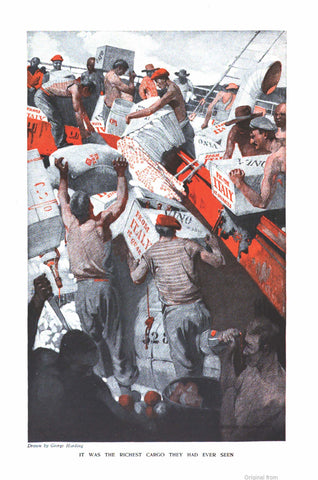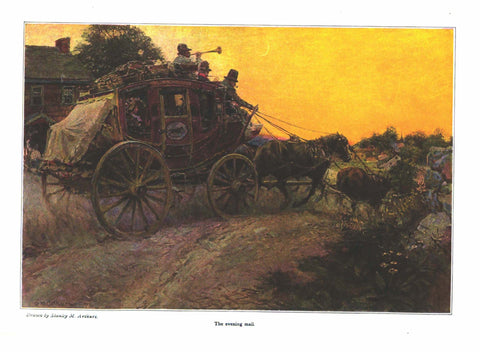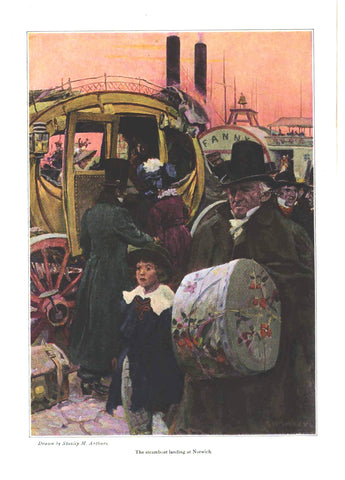Samuel Nelson Abbott advertisement illustration for Hart Schaffner & Marx: a beautifully framed antique
$325.00
"What Satisfies you in Clothes?"
By Samuel Nelson Abbott
Centerfold in The Saturday Evening Post
IMAGE INFORMATION
Image Size: H 13.25” x W 20.50”
Matted & Framed: H 20.25” x W 27.50”
Framed Price: $325.00
Packaging and shipping approximately $28.00
SNA went to France at the age of twenty where, like other American artists, he studied at the Academy Julian. He received reportedly instruction from Jean-Paul Laurens and Jean-Joseph Benjamin-Constant.
Laurens is remembered as “one of the last major exponents of the French Academic style." (His most celebrated student, George Barbier, was, however, pioneer in the Art Deco, a bold new mode of graphic design that was antithetical to Lauren’s academic formalism.) Benjamin-Constant was a celebrated figurist (Reclining Odalisque, 1879) and orientalist (Les nuits arabes, undated)
Upon his return from France, in about 1898, SNA settled in New York. It seems he found work as a commercial artist. The earliest example of his work I was able to find is his cover illustration for Hart Schaffner & Marx's 1903 Fall Stylebook. Since cover images are highlight pieces, SNA had probably been working for the Chicago-based garment manufacturer for a few years before he produced this image.
The stylebook was the brainchild of HSM partner Joseph Schaffner. The first stylebook may have been produced in 1901. Over the next few years, under Schaffner’s watchful eye, these catalogues became increasingly sophisticated. Schaffner described his guiding idea as “advertising that does not advertise.” His targets were “preppies,” Ivy Leaguers, upwardly-mobile careerists advancing up the social ladder in America’s growing middle class, and individuals who wanted to look like members of their clubs.
It was Schaffner’s genius to provide these prosperous, ambitious consumers with the information about “men’s styles” and “what to wear.” What would Schaffner’s clothes-conscious customers look like in HSM’s stylish ensembles? He harnessed the artistic talents of SNA, Herbert Paus, Edward Penfield, and John Sheridan to show them. Working closely with his illustrators, Schaffner developed advertisements that created positive images of men wearing his company’s fine clothing. The Stylebooks in which these advertisements appeared were theme-based and featured “enthusiasms” like football games, horse racing, dog trials, yachting events, and private conversations in clubby salons.
SNA was so good with his art that people who looked at his characters envisioned themselves. They became trim and handsome, and they communed with other members of the leisure class at highbrow social events.
By the middle of the first decade of the new century, HSM’s stylebooks featured four-color halftone images that made SNA’s illustrations even more mesmerizing. His female characters were fresh and charming. And they were invariably as absorbed in the play, the jump, and the tack as their impeccably dressed escort. The scenes were set pieces. Natural. Comfortable. Polished. Self-satisfying.
SNA must have enjoyed creating these scenes. It is reasonable to suppose that he gathered his material while cheering Princeton’s Tigers on against Dartmouth’s Indians, while watching cup races at Newport, while handicapping the field as jockeys saddled up in Belmont’s paddock.
For 25 years, SNA was the lead artist for HSM’s Stylebooks. Illustrations by Paus, Penfield, and Sheridan also appear in these publications. Perhaps because these men were paid by the piece that they signed their works. SNA did not. We know which ones were his because of their appearance. He has a certain way of drawing gloved hands. His characters wear slouch hats in the country and fedoras in town. The gentle folds of his fabrics show their quality. His coloring is also recognizable. He highlights his scenes with bright red and purples his shadows. Backgrounds are often a shade of gold. He uses bright contrasting colors to produce auras of intimacy that lift his characters out of the rooms, the fields, and the launches where they are engaged in their entertainments.
Between 1908 and 1920, SNA seems to have produced only advertisement illustrations for HSM. After 1920, he began producing covers for leading magazines including the Saturday Evening Post, The Ladies' Home Journal and Woman’s Home Companion. The first two were publications of the Curtis Publishing Company of Philadelphia.
This centerfold advertisement is a three-color halftone reproduction (with Red, Blue, and Black) of a full color illustration printed originally in HSM’s Spring and Summer 1921 Stylebook.








